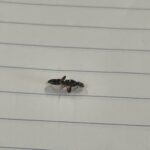Sample information |
|
| Picture |

|
|---|---|
| Location | |
| Collection date | 09/24/2024 |
| Captive / Cultivated? | Wild-caught |
| Group | Edmund Burke School |
| Observations |
|
| Putative identification | Arthropoda Insecta Orthoptera Rhaphidophoridae Tachycines Tachycines asynamorus |
Methods |
|
| Extraction kit | DNeasy (Qiagen) |
| DNA extraction location | Abdomen |
| Single or Duplex PCR | Single Reaction |
| Gel electrophoresis system | MiniOne |
| Buffer | TBE |
| DNA stain | GelGreen |
| Gel images |


|
| Protocol notes |
DNA Extraction
PCR”:
Gel electrophoresis, Arthropod CO1
Gel electrophoresis, Wolbachia
|
Results |
|
| Wolbachia presence | No |
| Confidence level | Medium |
| Explanation of confidence level | There was a moment when we forgot to switch pipettes between samples but it doesn’t seem to have affected the experiment. The controls worked as planned further proving the validity of our gels. |
| Wolbachia 16S sequence | |
| Arthropod COI sequence |
|
| Summary | The Tachycines asynamorus was found to be negative for Wolbachia. |
 European Paper Wasp
European Paper Wasp Woodworm Ant
Woodworm Ant